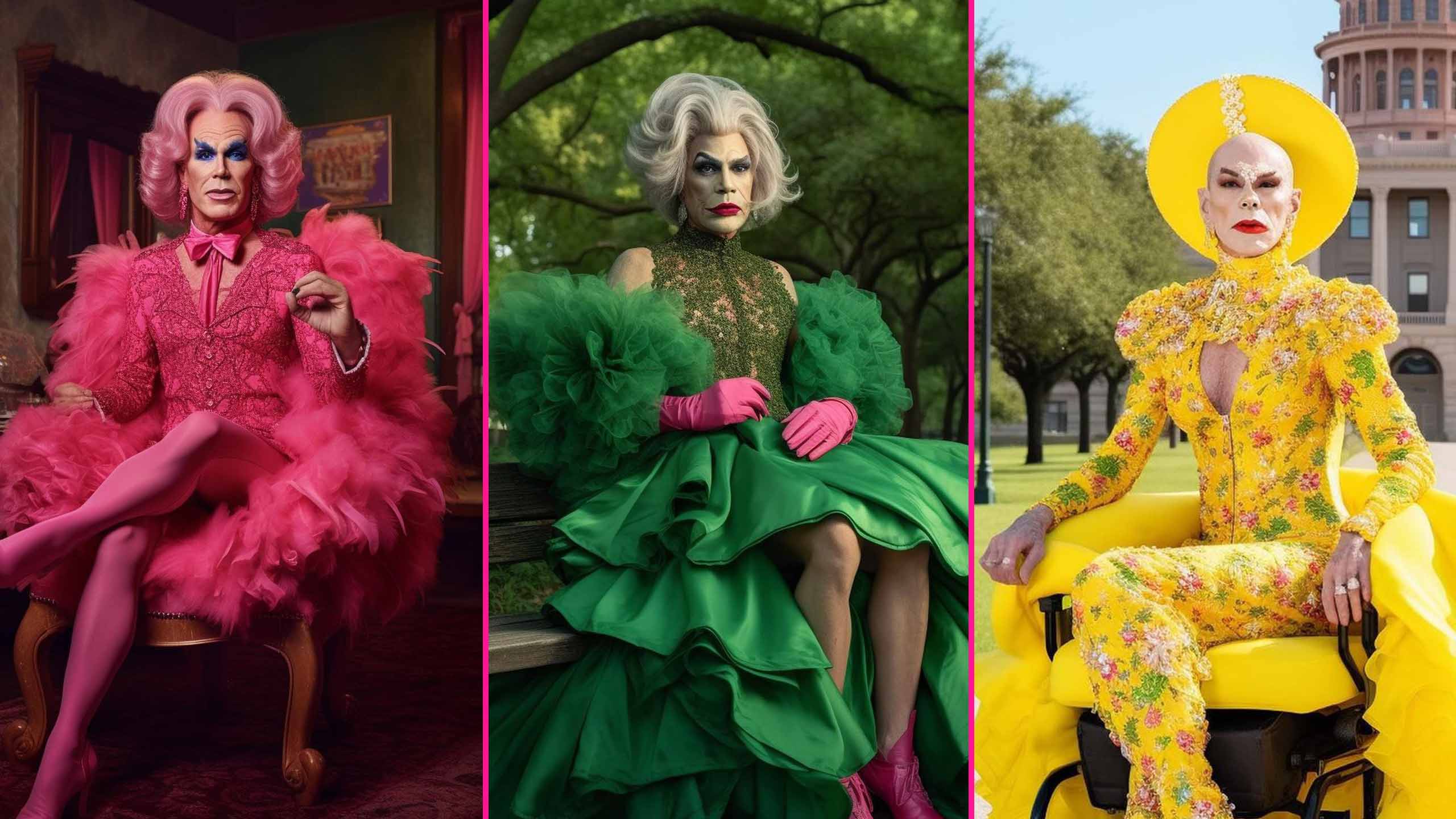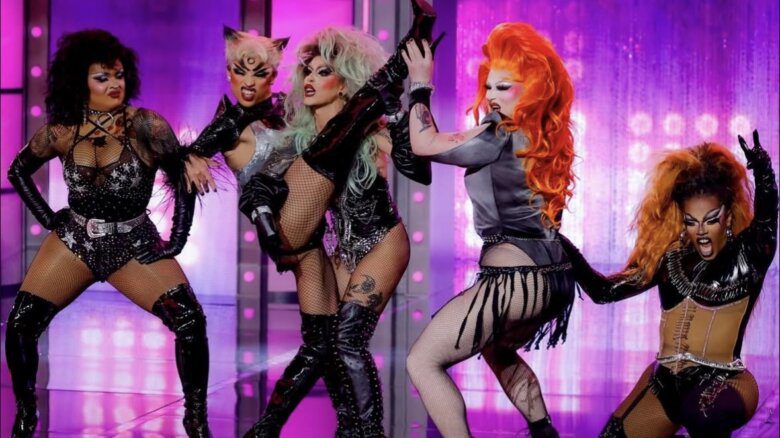“GOP stands for Glamour On Point.” These are not the words you most likely expect to hear coming from Clarence Thomas, the most conservative justice on the U.S. Supreme Court, especially in a clip where he seems to be offering his best Katy Perry impression: a pastel blue wig, knee-length dress and a bright yellow parasol in hand. Then again, this isn’t the actual Thomas.
The popular video I’m referencing was uploaded by the TikTok user Obscuriousmind, but the images of Thomas and other right-wing U.S. politicians first appeared on an Instagram account called RuPublicans at the end of March. Perhaps you’ve even seen these images, which went viral across a range of social media platforms last month. The RuPublican queens of Instagram were created by partners Craig and Stephen with the help of Midjourney—a text-to-image generator that was able to produce stunning visuals for the couple’s creative prompts. With concerns for their safety, the couple has asked media outlets not to publish their last names. According to the Advocate, the project is a means of pushing back against the latest surge of legislation from Republican lawmakers intent on restricting and even banning drag performances in a number of U.S. states, relying largely on frustrating and bizarre claims around grooming.
“We’re huge fans of drag, and we were bearing witness to the GOP’s anti-drag rhetoric and action,” Craig said in an interview with NBC News last month. “We wanted to do something about it, so we said, ‘Let’s put the GOP in drag.’” And that’s just what they’ve done. Their posts include former U.S. vice president Mike Pence as Mother Pence, the recently fired-by-Fox Tucker Carlson as a dolled-up Miss Glitzy Mothuh Tuckuh and Texas senator Ted Cruz as Cruzella Deville.
Craig and Stephen’s images received a massive wave of attention both on social media (garnering them over 250,000 Instagram followers in a little over a month) and across outlets like the Advocate, TIME and Logo, with most of this coverage focusing on the beneficial opportunities afforded by new AI programs like Midjourney, which allow users an easy point of access to bringing their own creative prompts to life. Yet, as a digital culture researcher, I’m interested in the broader contexts of these technologies. How, for example, do these posts highlight a lineage of online remixing practices? And how might reflecting on this history help to inform our current engagements with AI tools?
“It’s sort of a distilled and remixed version of human culture [and] human knowledge,” observes programmer and researcher Brian Christian on a recent episode of the Radiotopia podcast Bot Love, which focuses on our evolving relationship with digital apps and platforms. In reflecting on the output produced by our new AI models, Christian draws on the idea of the “remix,” a useful framework for deconstructing the way a program like Midjourney draws on giant datasets of earlier works in order to create its output. As the legal scholar and political activist Lawrence Lessig observed in Remix: Making Art and Commerce Thrive in the Hybrid Economy, a remix operates “by leveraging the meaning created by the reference to build something new.” More simply put, remixes are created whenever we copy, transform or combine existing materials in order to create something new.
We’re all familiar with this act. After all, it pervades the music industry. Through sampling, artists embed fragments of older songs into their new recordings. Nicki Minaj, for instance, draws on both the lyrics and the beat of Rick James’s 1981 hit “Super Freak” in her 2022 single “Super Freaky Girl.” That’s a remix. And remixes can be visual, too, as with the homages to Mean Girls, Legally Blonde and other turn-of-the-millennium blockbuster films in Ariana Grande’s music video for “thank u, next.”
But why do we remix? Well, there are a number of reasons why we tend to take up this practice: remixing can emphasize a point, reframe an idea, flip a perspective or even parody a subject. In the case of the RuPublicans, we can see all of these ideas at work. The simple humour that results from flipping the roles so often associated with these conservative politicians stresses how absurd their rhetoric has been—more absurd than the clever quips that their AI-selves have been programmed to say.
While remixing has existed since the dawn of culture, the participatory nature of our current internet landscape has made remixing practices easier than ever. Just think of how quickly a meme can evolve from “right in front of my salad?” to “realizing ‘where right in front of my salad?’ came from!” to “rofling as straight people figure out where ‘right in front of my salad?’ originated.” Thanks to digital tools like meme generators and platforms like Instagram and TikTok, the threshold for creating a remix and broadcasting it to others is remarkably low. Look through your own feeds at the posts that recycle audio, clips and trends; most of us are consuming remixes—and even creating remixes of our own—on a daily basis.
In conversations addressing the pros and cons of AI-generated art, the idea that these tools increase accessibility to a wider number of users is similarly a benefit often suggested in favour of these tools. And democratizing tools can be especially useful for groups whose voices and perspectives have historically been more silenced, ignored or marginalized. As Legacy Russell, the author of Glitch Feminism: A Manifesto, has observed, “Queer people, people of colour and female-identifying people have an enduring and historical relationship to the notion of ‘remix.’” She goes on to note that remixing is all about making something new with materials that are anything but—innovating via the everyday. Stephen and Craig have latched on to this history as they expand the RuPublicans family. “This has opened up a door for us that’s still being loaded before us,” the latter said in an interview with the Advocate.
While enjoying the RuPublicans account, we still ought to keep one eye on the challenges that remixing presents. For, as long as the act of remixing has existed, pieces that draw too heavily from earlier works have led to disputes over ownership. This, especially, has been one of the worries with AI art. Whose earlier artworks are models like Midjourney being trained on, and how are these artists being reimbursed for their labour (or even credited)? Who’s represented by these datasets? Who benefits and who pays the costs? When enacting remixes as part of a queer lineage, these questions might seem easy to dismiss, but what happens when similar remixing strategies are taken up by folks who have historically held greater resources and access to distribution?
This question becomes particularly interesting, I think, as we return to the latest remix of the RuPublicans. Craig and Stephen have regarded their AI art as a form of activism, but the Obscuriousmind TikTok reel has no such purpose in mind. In a YouTube video explaining how he was able to add sound and video to the RuPublican images (through additional AI art platforms), the TikTok creator adds, “There’s no sort of statement I was trying to make with this by the way. I just thought it was funny. I plan to make something aimed at the other side as well.”
In drawing attention to this last claim, I don’t mean to say that AI art can’t be an effective medium. Still, Obscuriousmind’s words serve as a useful reminder: these tools are just that—tools—and how we use them matters.


 Why you can trust Xtra
Why you can trust Xtra


